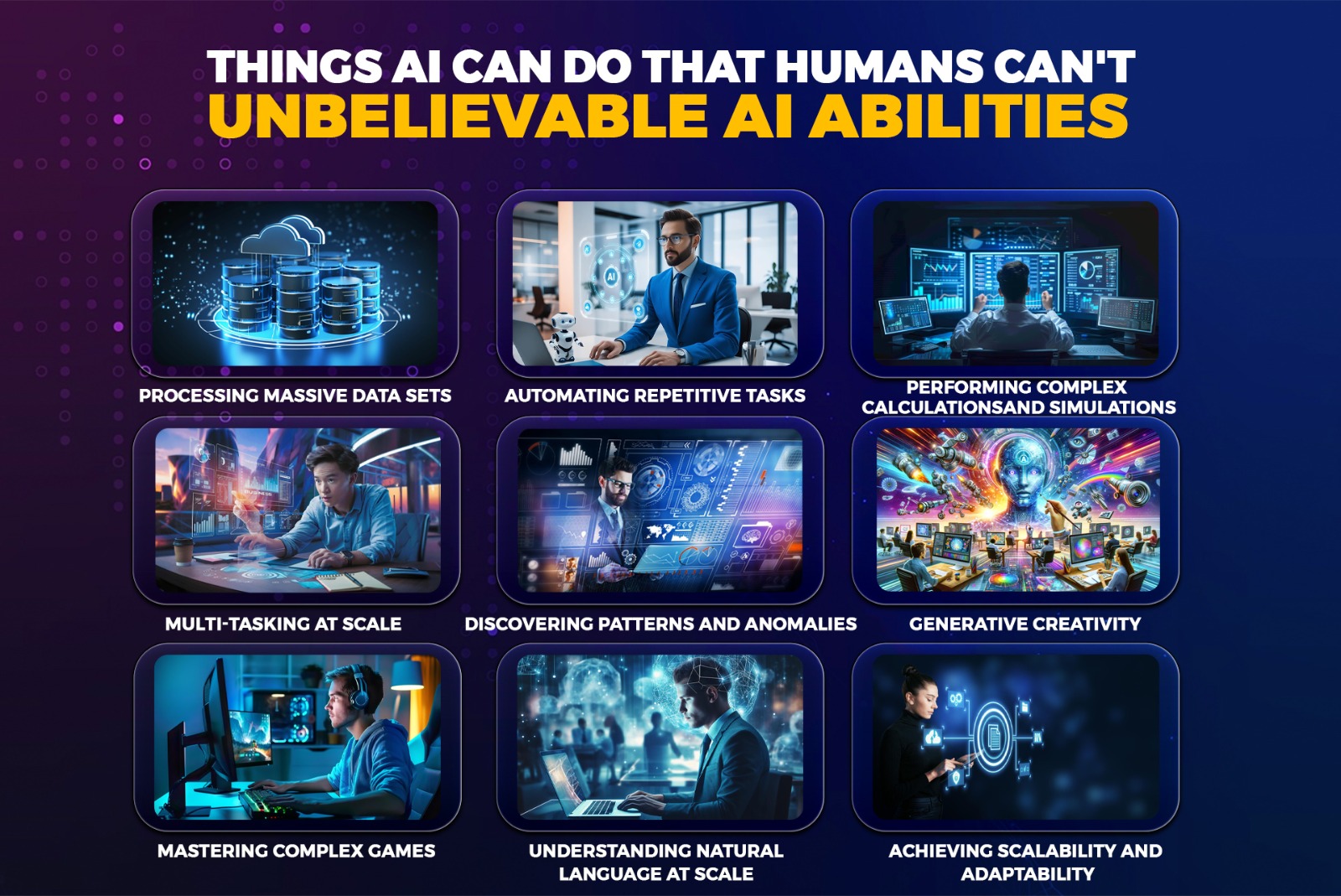Things AI Can Do That Humans Can’t: Unbelievable AI Abilities
Artificial intelligence has become a transformative force, surpassing human capabilities in many areas through advanced algorithms, machine learning, and neural networks. This blog highlights key areas where AI outperforms humans, reshaping industries and driving innovation.
Processing Massive Data Sets
AI processes vast datasets faster than humans, leveraging distributed computing and high-performance hardware (e.g., GPUs). Its ability to identify patterns and anomalies is invaluable in big data analytics, genomic research, and real-time monitoring. (Smith, 2023)
Automating Repetitive Tasks
AI excels at automating monotonous tasks such as data entry and document processing without fatigue or error. This boosts productivity and allows humans to focus on creative and strategic activities. (Johnson & Lee, 2022)
Performing Complex Calculations and Simulations
With specialized hardware like TPUs, AI performs calculations and simulations at unprecedented speed. This capability drives advancements in weather forecasting, financial modeling, and engineering design. (Brown et al., 2022)
Multi-Tasking at Scale
AI leverages parallel processing to handle multiple tasks simultaneously, such as managing customer service chats or optimizing supply chains. (Patel, 2021)
Discovering Patterns and Anomalies
Using machine learning algorithms, AI detects subtle patterns and anomalies in fields like cybersecurity and healthcare, often identifying issues humans might miss. (Williams, 2023)
Generative Creativity
Through models like GANs and transformers, AI produces creative outputs such as images, music, and text by learning from large datasets. (Anderson, 2022)
Mastering Complex Games
AI systems, such as DeepMind’s AlphaGo, use reinforcement learning to outperform human players in games with vast move possibilities. (Nguyen, 2021)
Understanding Natural Language at Scale
AI processes and interprets vast amounts of text, enabling tasks like translation and sentiment analysis with unmatched speed and consistency. (Chen & Kumar, 2022)

Achieving Scalability and Adaptability
AI scales efficiently using cloud infrastructure and continuously improves through machine learning, adapting to evolving datasets and challenges. (Miller, 2023)
AI’s abilities redefine possibilities across industries, from healthcare to manufacturing. However, its rapid advancement demands ethical considerations to ensure responsible use. (Taylor, 2023)
For further assistance, visit our channel and refer this video link below
Unbelievable AI Abilities | Things AI Can Do That Humans Can’t | Turilytix | BIG-AI

References
- Anderson, P. (2022). Creative Machines: Exploring AI-Driven Art. Tech Press.
- Brown, J., Patel, S., & Williams, R. (2022). AI in Simulations and Modeling. Springer.
- Chen, L., & Kumar, R. (2022). Natural Language Processing at Scale. AI Today.
- Johnson, T., & Lee, M. (2022). Automation in the Digital Era. Future Tech.
- Miller, D. (2023). Scalable AI Solutions. Innovate Press.
- Nguyen, H. (2021). AI and Game Mastery. DeepMind Insights.
- Smith, A. (2023). Big Data and AI Analytics. DataWorld.
- Taylor, K. (2023). Ethics in AI Development. Global Thinkers.
- Williams, R. (2023). AI for Anomaly Detection. Security Insights.
Share This :

